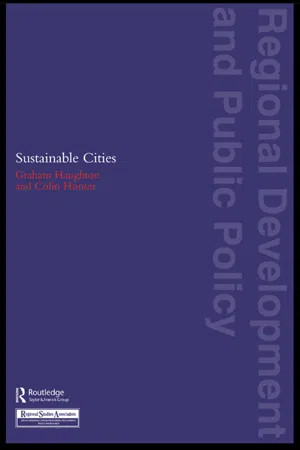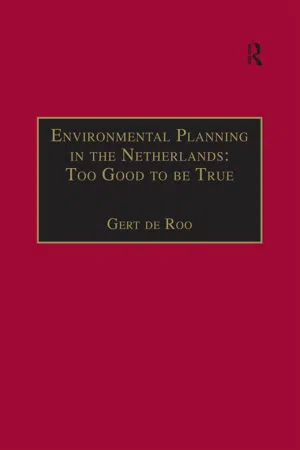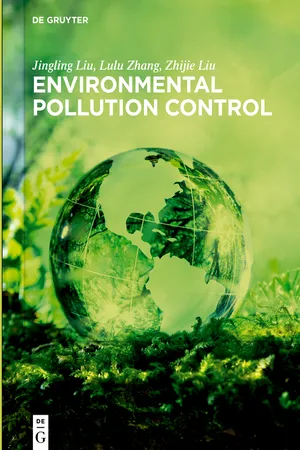Geography
Environmental Pollution
Environmental pollution refers to the introduction of harmful contaminants into the natural environment, causing adverse effects on ecosystems, human health, and the planet as a whole. This can include air, water, and soil pollution, as well as noise and light pollution. Human activities such as industrial processes, transportation, and waste disposal are major contributors to environmental pollution.
Written by Perlego with AI-assistance
Related key terms
4 Key excerpts on "Environmental Pollution"
- eBook - ePub
- Graham Haughton, Colin Hunter(Authors)
- 2004(Publication Date)
- Routledge(Publisher)
There are a number of reasons for this focus on air and water pollution. Air and water are clearly fundamental resources for life on Earth. The degradation of these resources via numerous forms of pollution is, arguably, the most significant threat to the integrity of the Earth’s ecological balance and the sustainable use of its resources. It is slowly becoming accepted that human societies cannot rely on nature to provide a continuous supply of clean air and water to sustain human activities, whilst at the same time expecting these resources to absorb and neutralise the waste products of human activities cheaply and effectively. Moreover, cities, as centres of resource consumption and waste production, exert an influence over the contamination of air and water which is greatly disproportionate to their physical size. Cities are, therefore, responsible for very many air and water pollution problems, both within and beyond urban boundaries. Furthermore, pollution arises from many different activities (e.g. energy production, transport, industry, domestic waste disposal etc.) and as such provides a useful insight into the range of human endeavours which impact on the quality and functioning of the natural environment. Finally, the sources and effects of air and water pollution, although very far from being fully understood and appreciated, have been widely investigated around the world. These studies have contributed to a growing disquiet concerning pollution impacts on human health and the functioning of natural ecosystems. At present, much of the world’s pollution is sourced in the developed countries; the North, with 25% of the world’s population, consumes 70% of the world’s energy, 75% of its metals, and 85% of its wood, whilst the citizens of developed countries also own 92% of the world’s cars (Tolba and El-Kholy 1992).THE NATURE OF POLLUTION
Pollutants are substances or forms of energy which cause environmental changes over and above those associated with natural background variation. A commonly-used description of pollution stresses its anthropogenic (human-made) nature: the introduction by humans into the environment of substances or energy which may result in hazards to human health, harm to living resources and ecological systems, damage to structures or amenity, or interference with the legitimate use of the environment (Holdgate 1979). Pollution may arise when the waste products of human activities are released into the environment at a point (e.g. a sewage outfall pipe), along a line (e.g. a road), or over a particular area (e.g. a landfill site used for domestic waste).The range of pollutants commonly generated by urban activities is enormous, and encompasses forms of energy (such as excess heat, noise and radioactivity) as well as substances. A bewildering ‘cocktail’ of organic and inorganic materials is continuously emitted to air, water and soil through routine urban living. These materials may react with each other or with natural constituents in the environment to produce yet more, secondary, pollutants. A great deal of technical expertise is required to untangle the importance and effects of individual pollutants or pollutants acting in combination. However, specialist knowledge is not required to appreciate the sources and consequences of pollutants in the environment. The following two chapters aim to provide such a broad perspective. - eBook - ePub
Environmental Planning in the Netherlands: Too Good to be True
From Command-and-Control Planning to Shared Governance
- Gert de Roo(Author)
- 2017(Publication Date)
- Routledge(Publisher)
17 By extension, although they fall to some extent outside the scope of the definition of Environmental Pollution, inner-city climate changes can also affect the liveability of the urban environment (Hough 1989, Miura 1997). This also applies to the possible synergy and cumulative effects caused by the interaction between various types of environmental impact. These effects are also outside the scope of this study.The forms of pollution that are within the scope of this study can, broadly speaking, be said to involve a ‘tapering effect’. The level of concentration and therefore the effect of the pollution fall in proportion to the distance from the source.18 As the level of concentration falls, so does the extent to which it is perceived or classified as impact.19 This relationship to distance exists until the point at which the emission is diluted to a level at or below the background level.20It is not so that all forms of Environmental Pollution adversely affect human health, or have ecological or spatial consequences. This obviously depends on the nature and scale of the pollution, but the way in which pollutants enter the environment is also important. Over the past century we have seen that man has tried to prevent as far as possible the undesirable effects of these emissions by deflecting them to a higher geographic level, or a longer time scale (see also § 5.3). As emissions are deflected, the relationship between environmental health and spatial development will become less direct and will diminish. It will also be more difficult to trace the relationship between the source of emissions and the effects of immisions to individual incidents of ‘cause-and-effect’. In such cases, undesirable and detrimental effects on the physical environment will be spread over a large area, and will only become apparent in the long term. The interaction between environmental health and hygiene and spatial developments with undesirable and detrimental effects will be greater than if there were a direct, identifiable relationship - that can also be located in spatial terms -between an individual source and a separate local effect. - eBook - ePub
The Environment
A Sociological Introduction
- Philip W. Sutton(Author)
- 2013(Publication Date)
- Polity(Publisher)
Alongside this, we also need to think about the issue of risk and the apparent precariousness of modern life. This is necessary because since the late twentieth century, some sociologists have argued that we are entering a period characterized by ‘risk societies’, which have to spend a good deal of their time and energy dealing with the hazards and risks generated simply by the continuing way of life that has also given the industrialized world its material wealth and relatively comfortable lifestyles. In this sense, we can ask whether the environmental ‘bads’ have started to overtake the material ‘goods’ we all took for granted.Types of PollutionPollution can be simply defined as the release of potentially harmful contaminants into the environment. However, such contaminants usually have to be released by human activity to be considered as ‘pollution’. Gases and materials released during volcanic eruptions may well cause harm to humans and other animals, but although technically they do pollute, they are not generally described as such. Carbon dioxide emitted from the burning of fossil fuels in power plants is considered polluting even though this gas does occur naturally anyway. This being the case, pollution is probably best seen as an inevitable aspect of the emergence of human societies. It represents the potential ‘dark side’ of human societies, population expansion and technological development. Pollution therefore cannot be avoided, though the extent of pollution and the types of pollution produced in societies do differ widely.We can narrow the different types of pollution down to those that affect the air, those that affect the water and those that affect the land. However, beyond these three main types, almost anything can be considered as polluting to human societies. Householders will go to court to stop their neighbours’ noise from polluting their living-room environment with loud music, and the International Dark-Sky Association campaigns ‘to protect and preserve the night-time environment and our heritage of dark skies through quality outdoor lighting’. You may be sympathetic to the latter cause should you ever want to see the stars the way your grandparents could, but find your view obscured by the hazy orange glow of badly designed street lighting that releases as much light pollution upwards to the sky as downwards onto pavements. There are obviously many more possible ‘pollutants’, but in this chapter we will concentrate on the three main types noted above. - eBook - ePub
- Jingling Liu, Lulu Zhang, Zhijie Liu, China Environment Publishing Group(Authors)
- 2017(Publication Date)
- De Gruyter(Publisher)
- Pollutants can enter the environment naturally or can be caused by human activities (for example from burning coal). Most pollution from anthropogenic activities occurs in or near urban and industrial areas, where pollutants are concentrated. Industrialized agriculture also is the major source of pollution.
- Pollutants could transform, metabolize, degrade, or be enriched in the environment through biological, physical, or chemical reactions, which result in property and concentration change in pollutants and then cause different harmful effects.
- Pollutants affect the human body in a long time through air, water, soil and food in various ways, for example, disruption of life-support systems for humans and other species; damage to wildlife, human health, and property; and nuisances such as noise and unpleasant smells, tastes, and sights.
Two approaches are commonly used to deal with pollution: 1 preventing pollution that comes into the environment or 2 cleaning it up if it did. Pollution prevention or pollution source control can reduce or eliminate the generation of pollutants. Pollution can be prevented by the following “five Rs” of resource use: refuse, replace, reduce, reuse, and recycle.Theory is the foundation and precondition for technology and management innovation, which determines the development, practice, and integration of Environmental Pollution control. The theory of sustainable development requires legal protection, technical support, and management practice to build, in order to ultimately be built into national/regional environmental security and early warning system.
Learn about this page
Index pages curate the most relevant extracts from our library of academic textbooks. They’ve been created using an in-house natural language model (NLM), each adding context and meaning to key research topics.



